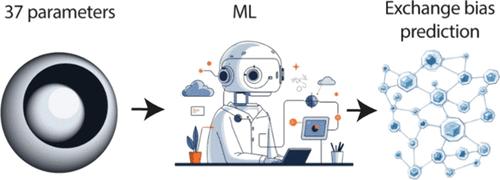Prediction of Exchange Bias for Magnetic Heterostructure Nanoparticles with Machine Learning
IF 3.2
3区 化学
Q2 CHEMISTRY, PHYSICAL
引用次数: 0
Abstract
Exchange bias is essential for the stability and control of nanoparticles’ magnetic properties for their application as rare-earth-free permanent magnet, magnetic storage, magnetic hyperthermia, and catalysis. Core–shell structures of magnetic bimagnetic particles have garnered increasing interest due to their larger coercive and exchange bias fields, tunable blocking temperatures, and enhanced Neel temperature. However, the design approach of nanoparticles with exchange bias using a computational method has a high computational cost and offers limited efficiency in predicting complex core–shell nanoparticle systems. Machine learning (ML) predictions provide a transformative approach to the design and optimization of materials with desirable exchange bias (EB) properties by offering rapid and precise evaluations of material compositions and configurations. This study addresses this gap by developing an ML model for the prediction of EB field in magnetic nanoparticles, which provide a fast and effective alternative for traditional computational methods. Hence, comparative analysis of ML models, including the Kolmogorov-Arnold Network (KAN), is for predicting EB in core–shell and heterostructure nanoparticles. Among the predictive models, XGBoost demonstrated superior performance, achieving R2 values of 0.74 and 0.75 on the test and validation data sets, respectively. KAN showed reduced generalization power with the R2 test of 0.67 but was more accurate in predicting high values of the EB. The Shapley additive explanation (SHAP) analysis revealed unexpected dependencies between nanoparticle properties and magnetic behavior, offering new insights for optimizing a material design. These findings are highly relevant for developing materials for rare-earth-free permanent magnets, magnetic storage, magnetic hyperthermia, and catalysis, where precise control of magnetic properties is crucial.

磁异质结构纳米颗粒交换偏置的机器学习预测
交换偏置对于纳米颗粒作为无稀土永磁体、磁存储、磁热疗和催化等应用的磁性能的稳定性和控制至关重要。磁性双磁粒子的核壳结构由于其较大的矫顽力和交换偏置场、可调的阻断温度和增强的尼尔温度而引起了越来越多的兴趣。然而,使用计算方法设计具有交换偏置的纳米粒子的方法计算成本高,并且在预测复杂的核-壳纳米粒子体系时效率有限。机器学习(ML)预测通过对材料成分和配置进行快速和精确的评估,为具有理想交换偏置(EB)特性的材料的设计和优化提供了一种变革方法。本研究通过开发一种预测磁性纳米颗粒中EB场的ML模型来解决这一问题,为传统的计算方法提供了一种快速有效的替代方法。因此,比较分析ML模型,包括Kolmogorov-Arnold网络(KAN),是预测核壳和异质结构纳米颗粒中EB的重要方法。在预测模型中,XGBoost表现出较好的性能,在测试和验证数据集上的R2值分别为0.74和0.75。KAN的泛化能力较低,R2检验为0.67,但在预测EB的高值方面更准确。Shapley加法解释(SHAP)分析揭示了纳米颗粒性能和磁性行为之间意想不到的相关性,为优化材料设计提供了新的见解。这些发现与开发无稀土永磁体、磁存储、磁热疗和催化等材料高度相关,在这些材料中,精确控制磁性是至关重要的。
本文章由计算机程序翻译,如有差异,请以英文原文为准。
求助全文
约1分钟内获得全文
求助全文
来源期刊

The Journal of Physical Chemistry C
化学-材料科学:综合
CiteScore
6.50
自引率
8.10%
发文量
2047
审稿时长
1.8 months
期刊介绍:
The Journal of Physical Chemistry A/B/C is devoted to reporting new and original experimental and theoretical basic research of interest to physical chemists, biophysical chemists, and chemical physicists.
 求助内容:
求助内容: 应助结果提醒方式:
应助结果提醒方式:


